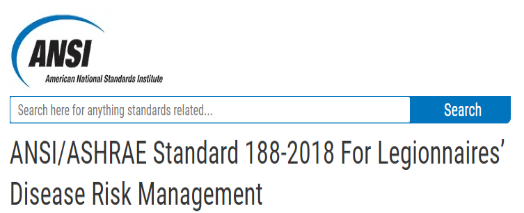Did you know that ASHRAE has a standard Legionaires’ disease? It is ANSI/ASHRAE Standard 188-2018 For Legionnaires’ Disease Risk Management
This ansi blog has done a nice job explaining what Legionnaires’ disease is. Legionnaires’ disease is understood as a form of pneumonia, or lung inflammation often caused by infection, and its culprit is the Legionella bacterium, which people can be exposed to after inhaling microscopic water droplets containing the bacteria. Following exposure, Legionnaires’ disease usually develops after two to ten days, and it is marked by the initial symptoms of headache, muscle pain, chills, and a fever that can go beyond 104°F (40°C).
 After a few days have passed, those inflicted with Legionnaires’ disease can experience a severe cough, shortness of breath, chest pain, gastrointestinal symptoms, and confusion or other mental changes. The disease can be fatal. The elderly, heavy smokers, people with weak immune systems, people with underlying illnesses like diabetes, and those with chronic lung disease are especially susceptible to Legionnaires’ disease. While it generally afflicts the lungs, the illness can cause infections in wounds and in other parts of the body.
After a few days have passed, those inflicted with Legionnaires’ disease can experience a severe cough, shortness of breath, chest pain, gastrointestinal symptoms, and confusion or other mental changes. The disease can be fatal. The elderly, heavy smokers, people with weak immune systems, people with underlying illnesses like diabetes, and those with chronic lung disease are especially susceptible to Legionnaires’ disease. While it generally afflicts the lungs, the illness can cause infections in wounds and in other parts of the body.
While the Legionella bacteria enter the lungs through aspiration or by being aerosolized in water and then inhaled, Legionnaires’ disease is almost certainly not contagious, with there being only one case of the bacteria transmitting from person to person. Legionella exist naturally in rivers, lakes, and streams, where they are relatively harmless. It is only in certain environments that the bacteria can flourish and pose a health risk. In fact, the presence of Legionella bacteria in building water systems is not in itself sufficient to cause Legionnaires’ disease. Factors necessary for the presence of Legionnaires’ disease include building water system design and use conditions that promote the growth of Legionella, as well as a means of transmitting the bacteria to people in the building. Some outbreaks have been linked to hot tubs in cruise ships, grocery store mist machines, cooling towers in air conditioning systems, decorative fountains, swimming pools, physical therapy equipment, and water systems in hotels, hospitals, and nursing homes.
Read more at the ANSI Blog: ANSI/ASHRAE Standard 188-2018 For Legionnaires’ Disease Risk Management https://blog.ansi.org/?p=158538
At this link you will find for information on the Standard 188-2018.

